Related Research Articles

Panoramic paintings are massive artworks that reveal a wide, all-encompassing view of a particular subject, often a landscape, military battle, or historical event. They became especially popular in the 19th century in Europe and the United States, inciting opposition from some writers of Romantic poetry. A few have survived into the 21st century and are on public display. Typically shown in rotundas for viewing, panoramas were meant to be so lifelike they confused the spectator between what was real and what was image.
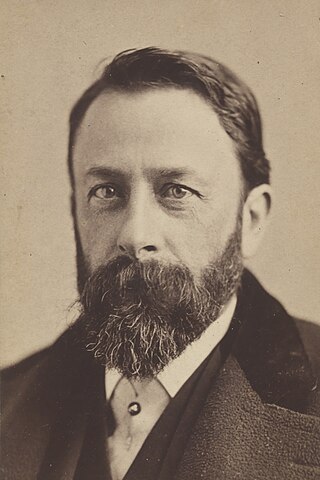
Albert Bierstadt was a German American painter best known for his lavish, sweeping landscapes of the American West. He joined several journeys of the Westward Expansion to paint the scenes. He was not the first artist to record the sites, but he was the foremost painter of them for the remainder of the 19th century.
A cyclorama is a panoramic image on the inside of a cylindrical platform, designed to give viewers standing in the middle of the cylinder a 360° view, and also a building designed to show a panoramic image. The intended effect is to make viewers, surrounded by the panoramic image, feel as if they were standing in the midst of the place depicted in the image.
Percy Gray was an American painter. At the 1915 Panama–Pacific International Exposition he won a bronze medal for his watercolor Out of the Desert, Oregon.

Thomas Hill was an American artist of the 19th century. He produced many fine paintings of the Californian landscape, in particular of the Yosemite Valley, as well as the White Mountains of New Hampshire.
The Battle of Gettysburg, also known as the Gettysburg Cyclorama, is a cyclorama painting by the French artist Paul Philippoteaux depicting Pickett's Charge, the climactic Confederate attack on the Union forces during the Battle of Gettysburg on July 3, 1863.
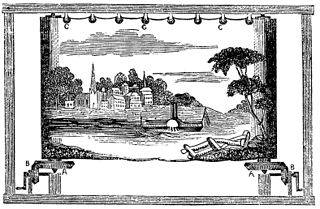
The moving panorama was an innovation on panoramic painting in the mid-nineteenth century. It was among the most popular forms of entertainment in the world, with hundreds of panoramas constantly on tour in the United Kingdom, the United States, and many European countries. Moving panoramas were often seen in melodramatic plays. It became a new visual element to theatre and helped incorporate a more realistic quality. Not only was it a special effect on stage, but it also served as an ancestor and platform to early cinema.

Jules Tavernier was a French painter, illustrator, and member of Hawaii’s Volcano School.
George Henry Burgess was an English American painter, wood engraver and lithographer. In London, he received training in lithography. With two other brothers preceding them, in 1850 Burgess traveled to California in the company of his brother Charles. Once there, the Burgess brothers set up a jewelry and watch repair business in Sonora. Unsuccessful at mining, George spent time sketching the gold fields and mining activity. In 1856, he made the first of three trips to Hawaii, where he painted the royal family and made preparations for lithographic views of Honolulu. In San Francisco, his primary source of income was painting portraits, but he often revisited the Gold Rush theme. Burgess' most well-known work is the massive San Francisco in July, 1849, now located at the Oakland Museum of California.

Chiura Obata was a well-known Japanese-American artist and popular art teacher. A self-described "roughneck", Obata went to the United States in 1903, at age 17. After initially working as an illustrator and commercial decorator, he had a successful career as a painter, following a 1927 summer spent in the Sierra Nevada, and was a faculty member in the Art Department at the University of California, Berkeley, from 1932 to 1954, interrupted by World War II, when he spent a year in an internment camp. He nevertheless emerged as a leading figure in the Northern California art scene and as an influential educator, teaching at the University of California, Berkeley, for nearly twenty years and acting as founding director of the art school at the Topaz internment camp. After his retirement, he continued to paint and to lead group tours to Japan to see gardens and art.
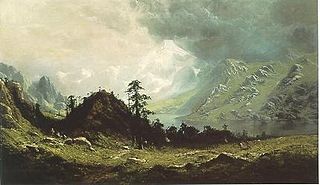
Ransome Gillet Holdredge was an early San Francisco school painter, specializing in Northern California landscapes.

William Keith was a Scottish-American painter famous for his California landscapes. He is associated with Tonalism and the American Barbizon school. Although most of his career was spent in California, he started out in New York, made two extended study trips to Europe, and had a studio in Boston in 1871–72 and one in New York in 1880.

The Ópusztaszer National Heritage Park is an open-air museum of Hungarian history in Ópusztaszer, Hungary. It was established in 1982 and is most famous for being the location of the Feszty Panorama, a cyclorama by Árpád Feszty and his assistants, depicting the beginning of the Hungarian conquest of the Carpathian Basin in 895. The painting was completed in 1894 for the 1000th anniversary of the event. The park is also home to various indoor and outdoor exhibits, focusing on the archaeological and ethnographic history of ancient and early-modern Hungary in an immersive and engaging manner.
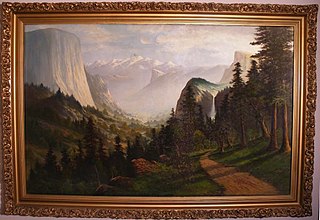
John Englehart or Joseph John Englehart (1867–1915), was an American landscape painter who worked under a number of pseudonyms. Englehart was born on June 14, 1867, in Chicago, Illinois, and died on April 14, 1915, in Oakland, California.
Dr. David G. Robinson, an American druggist by training, was an early theatrical pioneer in Northern California. Along with others, he established the San Francisco-Sacramento-Placerville entertainment circuit of the day; as well as some of San Francisco's first theaters.
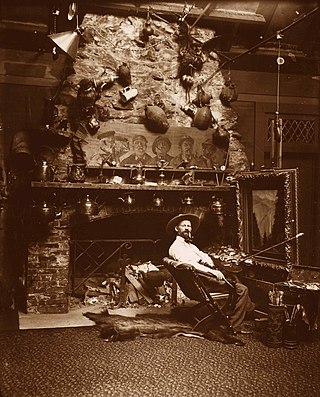
Christian August Jorgensen was a Norwegian-born American landscape painter. Jorgensen is best known for his paintings of Yosemite Valley and the California Missions.

Thomas Almond Ayres (1816-1858) was a California gold rush-era artist, most famous for drawing the first rendering of Yosemite Valley to be published and popularized. Ayres was born in Woodbridge, New Jersey in 1816. As a young adult, he moved to Wisconsin Territory and worked as a draftsman in what was to become St. Paul, Minnesota. In 1849, he went to California, embarking from New York on the steamship Panama on February 4. As the announcement of gold was only made by President Polk the previous December, this made Ayres among the first to head to the gold fields. He arrived in August, and immediately set out to the diggings. Like many fortune seekers, he was unlucky; however, he spent his time constructively, sketching many gold rush and other California scenes, eventually earning a reputation as a landscape artist.

Charles Arthur Fries (1854-1940) was an American painter active in Cincinnati and San Diego in the late nineteenth and early twentieth century. He is especially noted for his Impressionistic landscape paintings of southern California deserts and seascapes.
Robert Boardman Howard (1896–1983), was a prominent American artist active in Northern California in the first half of the twentieth century. He is also known as Robert Howard, Robert B. Howard and Bob Howard. Howard was celebrated for his graphic art, watercolors, oils, and murals, as well as his Art Deco bas-reliefs and his Modernist sculptures and mobiles.
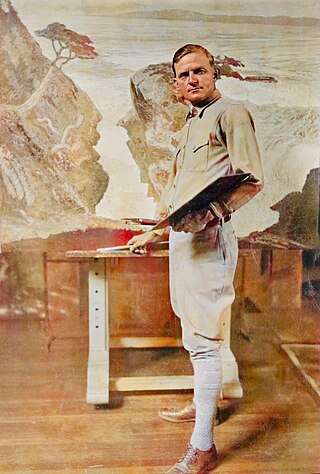
Ferdinand Burgdorff,, also known as Ferdy, was an American etcher, painter, and printmaker. He was nationally known for his role as a landscape painter of the Monterey Peninsula, Yosemite, and the dessert Southwest. He was one of the earliest artist that came to the art colony in Carmel-by-the-Sea. He was an illustrator for Sunset Magazine. His works can be found in the permanent collections of the Naval Postgraduate School, De Young Museum, Monterey Museum of Art, and the Cleveland Museum of Art.
References
- 1 2 3 The Overland monthly (Public domain ed.). Samuel Carson. 1896. pp. 35–. Retrieved 29 January 2012.
- 1 2 Palmquist, Peter E.; Kailbourn, Thomas R. (2000). Pioneer photographers of the far west: a biographical dictionary, 1840-1865. Stanford University Press. pp. 457–. ISBN 978-0-8047-3883-5 . Retrieved 29 January 2012.
- ↑ Zellman, Michael David (1986). 1842 - 1874. Chelsea House Publishers in association with American Art Analog. p. 446. ISBN 978-1-55546-002-0 . Retrieved 29 January 2012.
- ↑ "Charles Dorman Robinson: Ruins-Palenque, Yucatan - International Art Museum of America". 2021-12-26. Retrieved 2024-01-31.
- ↑ "Charles Dorman Robinson: Ruins-Palenque, Yucatan - International Art Museum of America". 2021-12-26. Retrieved 2024-01-31.
- ↑ "Charles Dorman Robinson: Ruins-Palenque, Yucatan - International Art Museum of America". 2021-12-26. Retrieved 2024-01-31.
- 1 2 3 Harper, Franklin (1913). Who's who on the Pacific Coast: a biographical compilation of notable living contemporaries west of the Rocky Mountains (Public domain ed.). Harper Pub. Co. pp. 483–. Retrieved 29 January 2012.
- 1 2 Godfrey, Elizabeth H . (April 1944). "THUMBNAIL SKETCHES OF YOSEMITE ARTISTS - CHARLES DORMAN ROBINSON" (PDF). Yosemite Nature Notes. THE YOSEMITE NATURALIST DEPARTMENT AND THE YOSEMITE NATURAL HISTORY ASSOCIATION. XXIII (4): 38–40.
- ↑ Manthorne, Katherine (1 November 1989). Tropical renaissance: North American artists exploring Latin America, 1839-1879 . Smithsonian Institution Press. pp. 103–. ISBN 978-0-87474-714-0 . Retrieved 29 January 2012.
- ↑ "Charles Dorman Robinson - A View of Mt. Tamalpais with Passing Clouds". Arader Galleries. Archived from the original on 21 December 2011. Retrieved 29 January 2012.
- ↑ Martin, Gloria Rexford; Gerdts, William H.; Santa Barbara Museum of Art (June 1996). A painter's paradise: artists and the California landscape : essays. Santa Barbara Museum of Art. p. 22. ISBN 978-0-89951-093-4 . Retrieved 29 January 2012.
- ↑ "Charles Dorman Robinson". Oakland Museum of California (OMCA) Collections. Retrieved 29 January 2012.
- ↑ Godfrey (1944), pp. 4
- ↑ Lekisch, Barbara (September 2003). Embracing scenes about Lakes Tahoe & Donner: painters, illustrators & sketch artists 1855-1915. Peter Browning. pp. 152–. ISBN 978-0-944220-14-6 . Retrieved 28 January 2012.